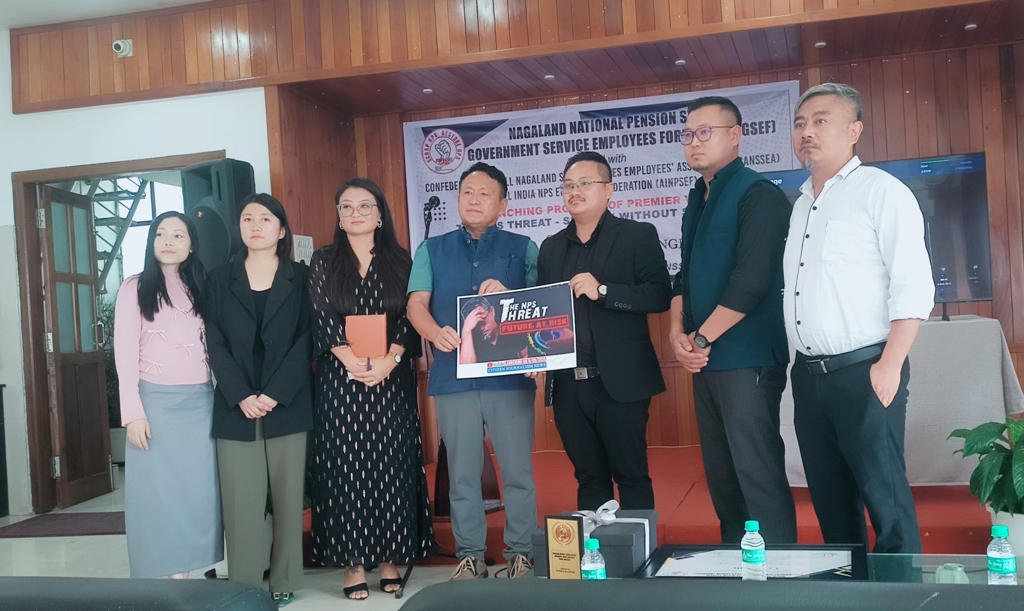TUESDAY, NOVEMBER 04, 2025
- Home
- ‘The NPS threat – service without security’ video launched in Kohima
‘The NPS threat – service without security’ video launched in Kohima
Nagaland National Pension System Government Service Employees Forum launches ‘The NPS threat – service without security’ video.
Share

KOHIMA — The Nagaland National Pension System Government Service Employees Forum (NNPSGSEF) on Saturday launched the premier video ‘The NPS threat – service without security’ at Hotel 2K, Kohima.
The video was launched by Zubemo Lotha Tsanglao, secretary of AISGEF and president of Confederation of All Nagaland State Services Employees Association (CANSSEA).
NNPSGSEF is affiliated to the CANSSEA and All India NPS Employees Federation (AINPSEF).
Also read: Fazl Ali College organises stage arrangement workshop
Addressing the event, Zubemo Lotha Tsanglao said that in every programme brought out by the government there is always a positive and negative side, stating that the National Pension System (NPS) is today’s reality for most government and private employees. It is designed to provide retirement savings, but like every system, it comes with both strengths and weaknesses.
On the positive side, he elaborated that NPS helps a person build a retirement corpus in a disciplined way where the money is professionally managed and diversified across equity, government bonds, and corporate debt, giving it the potential for higher returns in the long run.
But on the other side, Tsanglao stated that NPS does not guarantee a person a fixed lifelong pension like the Old Pension Scheme (OPS) did, wherein the retirement income depends on performance and annuity rates, which means it may often be lower, sometimes just 25 to 35% of the last salary, compared to 50% plus DA under OPS.
He maintained that there is no inflation-linked Dearness Allowance, whereas OPS had one, while he added that the real value of pension may fall over time as per market progress or downfall.
He said under NPS the employees must also contribute from their salary, while they cannot use the GPF facility, and at retirement at least 40% of the corpus must be locked into an annuity, which limits flexibility.
The CANSSEA President said, in a nutshell, NPS is a forward-looking system that combines growth, tax savings, and regulation, but it does not offer the certainty and security that OPS once provided.
He advised that the best approach is to recognise both sides, plan early, and use NPS along with other savings to ensure a financially independent retirement.
He informed that five states in India have rolled back from NPS to OPS, after knowing the negative side of NPS.
Tsanglao stated that the All India State Government Employees Federation (AISGEF) and aligned state-level employee associations have been campaigning to repeal the PFRDA Act, scrap NPS/UPS, and restore OPS starting from 2023 till date.
To roll back the NPS to OPS, he emphasised the need for legislative repeal, public mobilisation with greater outreach, and pressure on the political leadership. Furthermore, the CANSSEA president also expressed the association’s support for the NNPSGSEF in their fight with the state government and central government.
Avizo Nienu, president of NNPSGSEF, in his speech, said that the video is a project video that will serve as educational content.
“This video isn’t just a visual presentation; it’s a narrative that sheds light on the lives of government employees under the Old Pension Scheme (OPS) and highlights the shortcomings of the National Pension System (NPS). Through this educational content, we aim to inform every citizen about the pension systems that impact government employees,”
Nienu said that the video highlights the disparities faced by employees covered under the NPS compared to those under OPS, while he added that they have been deprived of equal rights, equal benefits, and social security available to OPS employees.
He informed that viewers of the video will see firsthand the challenges and uncertainties that NPS employees may encounter in their post-retirement life, as it was produced based on facts stated under the system of NPS.
Additionally, Nienu requested the state and central governments to consider their plea and take concrete steps towards ensuring the welfare and sustainable living of employees after retirement.

